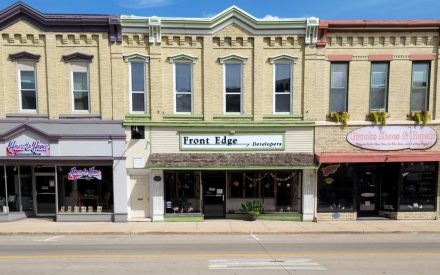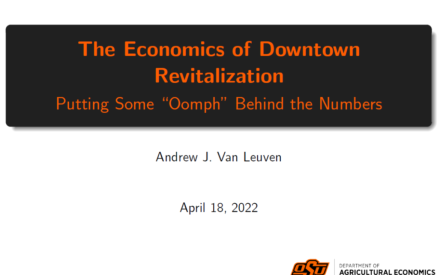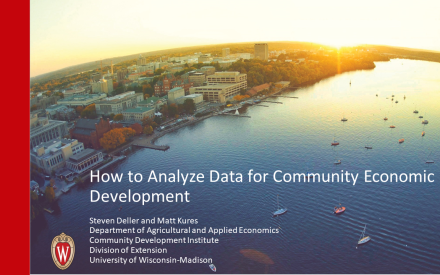
May 2022 — Economic trends provide important information that describes the health and vitality of the surrounding community and region. This information can help business operators and investors make informed decisions regarding development in the community. The information can also be used to identify potential opportunities for downtown as the central place in the community and region. These opportunities may result from downtown’s connection to area industry, institutions, and local amenities.
Industry Concentrations and Employers
Analyzing industry concentrations and employers focuses on economic activity within a community. The data being used includes people who work in the area, but may live in another region.
Earnings Mix
Breaking down earnings by sector provides a snapshot of the industry mix in an area. Earnings include wage and salary disbursements, other labor income, and proprietor’s income (both farm and non-farm). These numbers can be related as individual numbers, or as a percentage to provide an understanding of the industry distributions. Furthermore, comparing the numbers for a local area to those of a larger area, such as an entire state, point to differences in the local economy that may be useful in subsequent market analysis steps.
These figures are available through the Bureau of Economic Analysis.
Personal Income Trends
Personal income trends provide an important measure of regional economic activity over time. Per capita personal income is used as an indicator of the quality of consumer markets in an area, as well as a measure of residents’ economic well being. When compared to state or national trends, it provides one indication of how well the region’s economy is performing.
While income is derived from a variety of sources, wages and salaries are typically the largest components of a region’s income. The impact of average wages on personal income however, are likely offset by increases in other income sources (such as investment or retirement income) and increasing labor participation rates over this period (i.e. more earners per household).
The Bureau of Economic Analysis (BEA) prepares quarterly and annual estimates of personal income by and estimates of labor and proprietors’ earnings for all states.
Local Firm Employment
An analysis of local employers provides insight into the types of larger businesses in the area that may provide drawing power. In addition to this, large employers set the precedent of success within a community, which may reassure other prospective businesses. Furthermore, identifying these employers, their number of employees, and their locations may help in later analysis, as they aid in determining daytime employee populations for the trade area.
Employer listings are often available through your local chamber of commerce, your state employment department (e.g. Wisconsin Department of Workforce Development), or the U.S. Bureau of Labor Statistics.
Population: Employment Ratio to Analyze Local Markets
One common measure used to assess the region’s performance in capturing local markets as well as assess the level of relative dependence on a particular industry is the Population/Employment Ratio.
When analyzing population/employment ratios, population serves as a surrogate for regional demand, and employment can be considered regional supply. For this reason, it can be said that P:E Ratio represents a simple measure of regional supply and demand. When local ratios are compared with statewide or national ratios, it can be determined whether or not local demand is being met, if there are local expansion opportunities, or if the area is importing demand from surrounding regions.
A second interpretation of the P:E Ratio is that it provides a measure of relative dependence on specific industries. A P:E Ratio that is relatively small (i.e., high levels of employment given the region’s population) indicates higher levels of dependence. Conversely, a P:E Ratio that is relatively large indicates lower levels of dependence.
Location Quotient to Analyze Industry Concentrations
Another common tool used to analyze local economic strengths and weaknesses is the Location Quotient (LQ). Using employment or income data for local sectors, this tool measures the ability of the local market to capture local economic activity.
The Location Quotient’s critical value is one, which is equal to the national average. If the computed LQ is greater than one for any sector, then that sector is said to be a strength of that community; therefore, if the LQ is less than one, then the community is weak in that sector.
The Bureau of Labor Statistics provides a useful Location Quotient calculator on their website. This calculator allows you to find LQ’s for various industries and regions across the country. This calculator can be found on their website: www.bls.gov
Labor Force and Employment Levels
Labor force and employment data provide important information on the size and stability of a local economy as measured by the local workforce. Trends developed from this data can help new and existing businesses understand the strengths, weaknesses, and predictability of the area economy.
Trends in population growth (or decline) are sometimes used as a general measure of economic performance; that is, areas with rapidly growing populations typically have strong job growth. More importantly, looking at population estimates and projections will answer two key questions: What does the current workforce look like? What will the workforce look like in the future? By comparing local population growth to state or national population benchmarks, you can gain an understanding of how your local workforce is changing relative to the state or the nation.
Monthly estimates of unemployment rates for metropolitan areas (MSAs), counties, and states provide a rough measure of economic performance. Also, when compared to state and national unemployment rates, local unemployment rates can point out strong regional economies.
Labor force participation rates (LFPRs) measure the number of citizens employed or looking for employment as a percentage of the civilian non-institutional population. LFPR data help determine the factors that lead to discouraged workers, or workers that have dropped out of the labor force. Unfortunately, LFPRs are current only at the time of a decennial census.
There are many sources available to gather data on labor force, income, and employment.
- State Employment Departments
- The U.S. Census Bureau
- The Bureau of Labor Statistics provides data for unemployment and labor force participation
- The Bureau of Economic Analysis provides Employment by type, including wage and salary or proprietor
Entrepreneurial Activity
Measuring entrepreneurial activity is difficult as the definition of an entrepreneur varies. However, common measures of entrepreneurial activity do exist.
Number of Proprietors
The simplest way to measure entrepreneurial activity is by measuring the number of business proprietors, or self-employed people. This measurement has limitations, however. While the number of self-employed people may increase, these proprietors may be different. Some proprietors employ a large number of people as part of their businesses, and others may operate a business to support a lifestyle or for secondary income. Nonetheless, these trends suggest that local business owners are a growing part of the regional economy.
Proprietor’s Income
Trends in proprietor’s income provide additional perspectives on entrepreneurial activity. Proprietor’s income is an important gauge of economic performance because it captures the income contributions of locally-owned businesses. Local factors contributing to a lower average proprietor’s income are unknown, but could include a locally larger share of lifestyle-type entrepreneurs, or fewer large, locally-owned companies relative to other metro areas.
Your local chamber of commerce may have additional information on entrepreneurial activity in your area. In addition to this, many of the same sources used to find information on labor force and income can also be used to find information on entrepreneurial activity, including the U.S. Census Bureau.
Local and Regional Business Networks
Business networks such as Wisconsin’s New North, Michigan’s Detroit Young Professionals, or other organizations devoted to professional networking help create an environment that is welcome to new business leaders. Beyond simply networking, many organizations like these are devoted to the creation and expansion of business opportunities within their local area.
Your local chamber of commerce can identify business networks in your area.
Business Climate Analysis
The information discussed in this section covers some factors that reflect the business climate of your community. A proper business climate with stimulate growth and expansion within your community.
Retail Activity
Retail sales are a strong force within today’s economy. A local economy with high retail sales reflects a strong consumer base with a willingness to spend. A more detailed analysis of retail spending in a community is provided in the retail and service business opportunities section of this toolbox.
Retail sales measurements can collected from private data providers, or calculated from information found in the U.S. Economic Census, which is published every five years.
Tax Revenue
Sales tax revenue is another good measurement of consumption. While some goods are sales tax exempt, most consumer goods require sales tax to be paid. Sales tax revenue, as collected by county or state, shows the relative level of economic strength within the region measured. Furthermore, when broken down by industry, sales tax data shows the level of consumption within said industry. Higher levels of sales tax revenue indicate higher levels of consumption—a result of a strong economy and consumer base.
Sales tax revenue can be found through your state department of revenue, or a local taxing authority, if applicable.
Tax Structure and Incentives
Tax structure and incentives can provide lucrative opportunities for new business growth. An economic analysis should highlight the state and local tax structure, and emphasize any tax incentive programs relevant to business.
Information on the state tax structure and tax incentives for businesses can be found through these resources:
- Local chamber of commerce
- County or regional economic development corporation
- State department of revenue
- State department of workforce or economic development
Real Estate Activity
Real estate activity analysis incorporates several different real estate segments which are determined based on intended use. These segments include the markets for office, retail, industrial, and housing space.
Office Market
Understanding real estate trends in the market for office space can highlight areas of opportunity for expansion of white collar office accommodations. High vacancy rates and low absorption rates are typically negative indicators; however, some tenants may find this to be an opportunity.
Knowing the type of office space is also important. Office space is segmented by classes A, B, or C, based on their quality. Class A space usually is most competitive and has the highest rent (typically the result of a good location, condition, management, etc). Class C space, in contrast, is typically lower rent space in older buildings.
Important office market data includes:
- Gross available area
- Class composition (A,B, and C)
- Median rent per square foot
- Vacancy and absorption rates
Retail Market
Information about commercial real estate locations, size, growth, and retail mix serve as a measure of retail activity. Businesses want reassurance of the retail market vitality in an area. Providing this information to prospective retailers will ensure they are confident with a location.
Important retail market information includes:
- Size, growth and type of shopping centers
- Gross leasable area
- Tenant mix, number of stores, anchor stores
- Frontage, visibility, and parking
Industrial Market
Downtown industrial space is mostly used light for manufacturing or warehousing. While the requirements and desired attributes vary based on intended use, people looking to purchase or rent industrial real estate often focus on size, location, zoning, and available utilities.
Important factors include:
- Location relative to transportation infrastructure
- Land zoning, costs, and taxes
- Other uses of the district (manufacturing, warehousing, flex space)
- Available utilities
Housing Market
The development of new housing, whether it is single family homes or multi-family buildings, requires special analysis as presented in the housing section of the toolbox. Many factors play into the feasibility of new construction or building rehabilitation.
Building permits and new construction often indicate a strengthening economy, as do low vacancy and high absorption rates. Essential housing market data includes:
- Legal attributes and zoning restrictions
- Cost information (Median home value, rents, property tax, average utilities)
- Vacancy and Absorption rates
- Owner versus Rental property
- Permits and New Construction
- Physical information (average square foot, rentable area, waterfront, etc.)
This data is available through city and state sources. In addition, the U.S. Census Bureau’s Building Permits data reports construction statistics by place and by county on new privately owned residential housing units authorized by building permits.
The U.S. Census Bureau also provides additional data about home ownership, housing affordability, housing vacancy, market absorption of apartments, and housing patterns including residential segregation to see how affordable it is to buy or rent in various communities.
Transportation Patterns
Physical transportation infrastructure facilitates business development by transporting materials, goods, and people into and out of a community. This infrastructure may include the waterways and ports, railways, airports, and highways that connect a community other regions. Many smaller communities rely heavily on road traffic to attract visitors and business.
Traffic Volume
Understanding street and highway traffic volume is essential to strategic business placement. Retailers typically seek locations on major arteries and often rely on minimum average daily traffic counts to survive. More specifically, businesses such as gasoline stations, convenience stores and fast food restaurants choose locations based on traffic volume, ease of access, and visibility from high traffic streets and highways. Conversely, while high traffic counts are desirable, extreme traffic congestion can be a deterrent to shoppers. That is, high traffic may hinder visibility, parking and pedestrian friendliness.
While some private data providers sell traffic counts, this information can often be collected through statewide Department of Transportations.
Transit
Many citizens of larger communities rely on public transportation to travel between residential areas and business, shopping, and entertainment districts. Transit systems provide transportation for both customers and employees. For this reason, public transportation activity is important to businesses.
Information on transit routes can be found through your local transit authority.
Parking
A common issue with downtown business districts is parking. Poorly designed parking will deter people from frequenting downtown. For this reason, many businesses take parking into consideration when deciding where to locate.
Parking information is often found on local city websites.
Commuting Patterns
Commuting patterns highlight counties with a strong economic base which are able to attract workers from surrounding regions. Conversely, they also demonstrate which areas might lack local employment opportunities for their residents. These “bedroom” communities offer a greater number of housing options in comparison to other locations.
A valuable source to use to observe these commuting patterns is On the Map, an interactive mapping application, provided by the U.S. Census, shows in high definition where people live versus where they work.
Institutions
Large institutions often drive a local economy. These institutions can include educational facilities, federal research centers, medical centers, military bases, prison systems and government. Most major institutions provide stable employment opportunities, drawing people from surrounding areas. In addition to this, major universities and hospitals often attract students and employees from across the state and nation.
Because of the large role these institutions play within a local economy, communities with universities, hospitals, or other large facilities should emphasize the role these institutions play within their local economy.
Some important information includes:
- Employment by institution
- Number of users, patients, visitors, enrollees, etc.
- Funding and grants
- Other information (i.e. rankings, statistical descriptions, etc.)
Tourism and Community Attractions
Tourism is a driving force of many local economies. Analyzing tourist activity and the draw that large community events can create is an important step in the economic analysis of your community.
Measuring Tourism
Visitor expenditures create a chain effect. First, businesses and their employees receive direct revenue from tourists. These businesses and their employees then spend their income in the state, creating an indirect impact that supports additional jobs, wages, salaries, proprietary income and tax revenues. To state this more technically, the total economic impact of traveler expenditures is equal to the sum of the direct and indirect impact.
Tourism is not a typical industry, and cannot be represented in its entirety by a few NAICS-classified businesses. Tourism is the movement of people into an area for a brief period of time. Its economic impact begins with the sum of every dollar visitors spend on lodging, retail purchases, gas, food, entertainment or any other goods or services people buy.
More information and data on tourism in your area can be found at your state department of tourism.
Arts and Attractions
Major arts and attractions, such as sporting events, annual festivals, theaters, and farmer’s markets can draw many people from surrounding regions. These events can provide an economic boost to communities, especially smaller ones. Because of this, knowing attendance figures is important. Not only must these figures be known for safety and logistical purposes, but are businesses will benefit by being able to anticipate increased customer volumes. Also, many potential businesses may find these events to make a location more lucrative.
Most event organizers will have attendance figures to provide for you. In addition to this, large outdoor public events will often haven crowd estimates done by safety officials.
Quality of Life Measures
While definitions for quality of life vary by person, the role of quality of life in the economy has been well documented. Talent and companies are mobile and are often attracted to areas with an appealing quality of life. A growing body of research suggests that highly-educated individuals in many knowledge-based occupations are “consumers of place.” That is, these individuals are attracted to places with a high quality of life.
Even though there is no exact scale for measuring quality of life, it is possible to measure the factors that determine a person’s perception of life in the community. Some factors that affect quality of life include:
- Education. Because everyone wants their children to have access to high-quality schooling, quality of life often includes information about high school graduation rates, standardized test scores, and post-graduation plans.
- Health. Health has become important to many people in the U.S. The U.S. Department of Health and Human Services has a program to develop Community Health Status Indicators for each county in the United States. The CHSI provides an overview of over 200 key health indicators including mortality.
- Recreational Opportunities. Promoting recreational area creates an attractive image of your community. Information about recreational opportunities can be found on state park websites. Also, many local communities have information about local parks and other recreation on their websites as well.
- Unemployment Rates. While often considered an economic indicator, unemployment rates can affect the perception of a community. For more on employment data, please review the Labor Force and Employment Level section of the toolbox.
- Crime Rates. When starting new families, most people look for a safe, friendly neighborhood. For this reason, low crime rates are an excellent selling point for a community. Crime statistics can be received from local police departments, FBI.gov, and the Bureau of Justice Statistics.
- Household Income. Many people look for a satisfactory level of household income when determining quality of life. It must also be noted however, that affordable housing is an important factor to many. For more information about household income, please review the information in the earlier sections of this toolbox.
Appendix – Local Economics and GIS
GIS is able to turn a table of data into a useful map that can be analyzed. The maps created using GIS demonstrate information graphically. Some information, such as the distribution of downtown employees, is difficult to represent as a chart or table. GIS is able to turn these types of data into a useful, easy to analyze map. Accordingly, the following discussion demonstrates a very useful GIS application for analyzing local economic data.
Capturing the spending potential represented by downtown area employees requires that businesses are accessible to employees. To thrive in a downtown environment, businesses need locations accessible relative to places of employment. Research has indicated that most employees will not travel more than a quarter-mile from their place of employment to purchase a good or service during working hours. Accordingly, businesses seeking to capture the greatest amount of employee spending should consider a location within a quarter-mile of large employment centers. These location considerations may be particularly relevant for restaurants, retailers, personal services, convenience stores, health clubs and banking services.
The example map that follows examines the number of employees working throughout the study area. This map shows the estimated number of employees within a quarter-mile of any point on the map. The highest employee concentrations are found in the area bound by the Milwaukee River, Wells Street, Wisconsin Avenue and Jefferson Street. The blocks bound by these streets have 20,000 to 29,000 employees working within a quarter-mile.
Composite Data Site Examples
The following sites are considered composite as they bring together data from various sources and apply them in models that offer new insight into a community. Users should be aware that the reliability of data, when generated from other data, should be evaluated for reasonableness.
OnTheMap (US Censur) is a web-based mapping and reporting application that shows where workers are employed and where they live. It also provides companion reports on age, earnings, industry distributions, race, ethnicity, educational attainment, and sex.
Headwaters Economics Economic Profile System
The Economic Profile System is a free, easy-to-use tool that provides access to 17 socioeconomic reports. Customized reports are available for U.S. communities, counties, and states and can be downloaded as Excel or PDF files. Reports are based on credible public data sources such as the U.S. Bureau of Economic Analysis, U.S. Bureau of Labor Statistics, U.S. Census Bureau, U.S. Department of Interior, and U.S. Department of Agriculture. Data are updated continuously.
The Economic Opportunity Mapping (EOM) Tool
Michigan State University’s Economic Opportunity Mapping (EOM) Tool provides interactive online maps that allow users to visualize potential county-level economic opportunities for businesses in different industries across the United States. In addition to county summary statistics, the EOM tool provides a visual representation of results of a model producing expected industrial predicted presence. The model output is compared to measured values to categorize each county as above, below, or near predicted values for a specific industry. Measures of both expected and actual performance are subject to error and thus imperfect. The goal of these maps is to provide starting point to spur discussion and understanding of economic opportunities.
Data USA is a comprehensive website and visualization engine of public US Government data. Through advanced data analytics and visualization, it tells stories about: places in America—towns, cities and states; occupations, from teachers to welders to web developers; industries–where they are thriving, where they are declining and their interconnectedness to each other, and education and skills. Data USA puts public US Government data in your hands, instead of searching through multiple data sources that are often incomplete and difficult to access.
About the Toolbox and this Section
The 2022 update of the toolbox marks over two decades of change in our small city downtowns. It is designed to be a resource to help communities work with their Extension educator, consultant, or on their own to collect data, evaluate opportunities, and develop strategies to become a stronger economic and social center. It is a teaching tool to help build local capacity to make more informed decisions.
This free online resource has been developed and updated by over 100 university educators and graduate students from the University of Wisconsin – Madison, Division of Extension, the University of Minnesota Extension, the Ohio State University Extension, and Michigan State University – Extension. Other downtown and community development professionals have also contributed to its content.
The toolbox is aligned with the principles of the National Main Street Center. The Wisconsin Main Street Program was a key partner in the development of the initial release of the toolbox. One of the purposes of the toolbox has been to expand the examination of downtowns by involving university educators and researchers from a broad variety of perspectives.
The current contributors to each section are identified by name and email at the beginning of each section. For more information or to discuss a particular topic, contact us.












 How to Utilize Data for Community Economic Development (Part II)
How to Utilize Data for Community Economic Development (Part II) How to Access Data for Community Economic Development (Part I)
How to Access Data for Community Economic Development (Part I) Focus Group Analysis Tips
Focus Group Analysis Tips Developing Questions for Focus Group Interviews
Developing Questions for Focus Group Interviews


